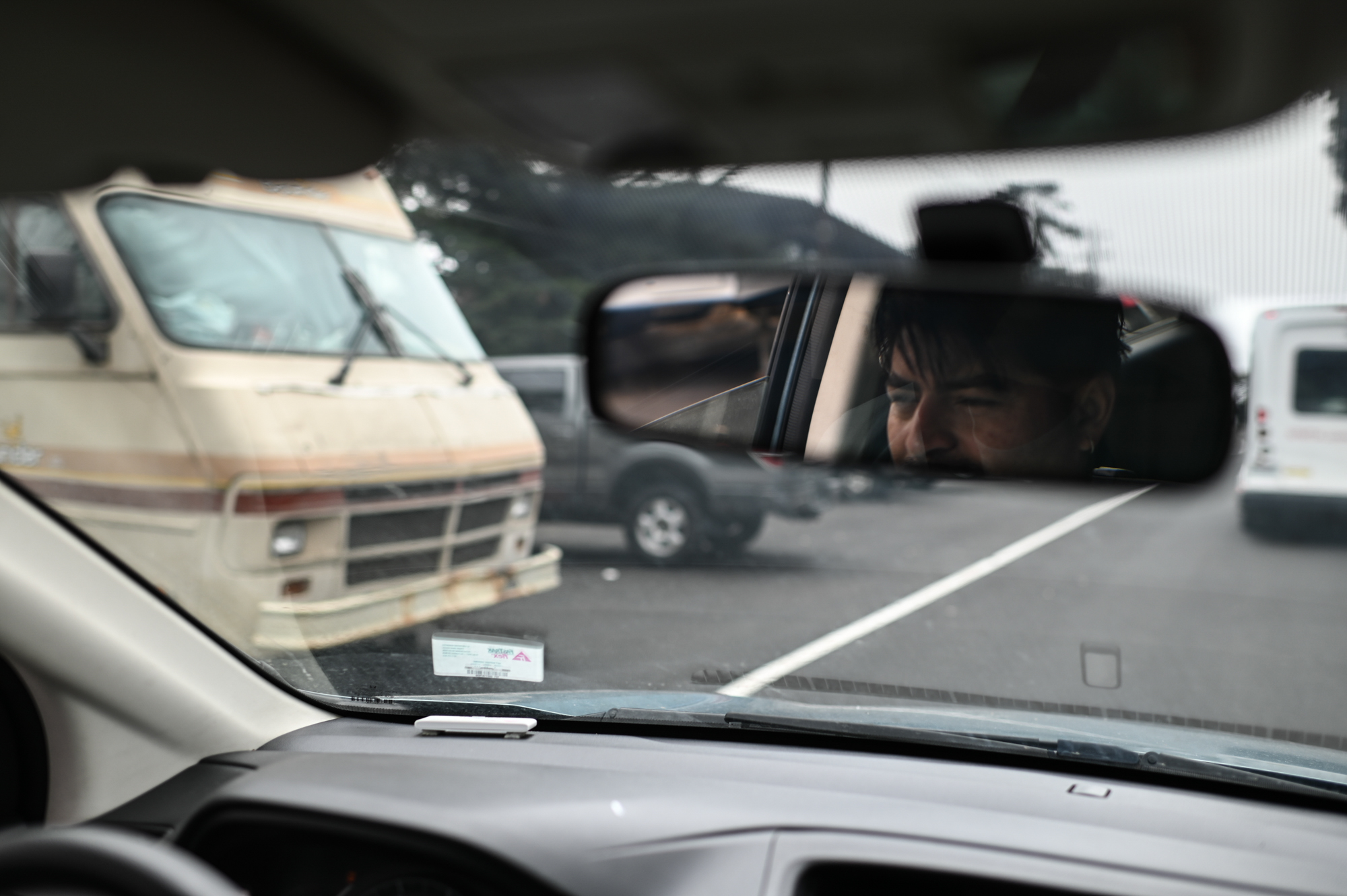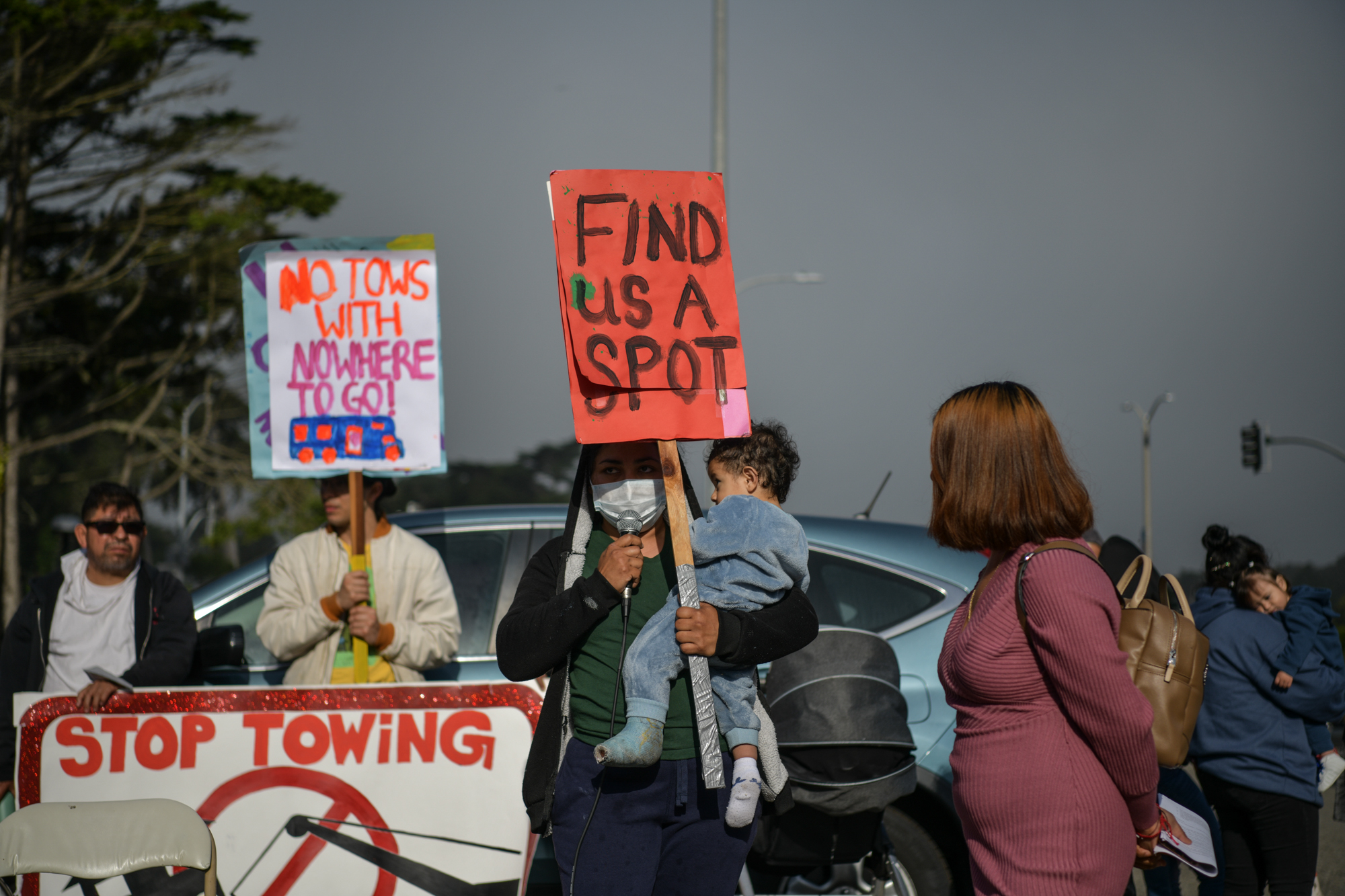“Keep in mind that this enforcement won’t lead to towing,” SFMTA liaison Joél Ramos wrote in a July 2024 e-mail. “It’s the Supervisor’s hope that the risk and/or issuance of parking citations alone will lead to folks transferring the RVs.”
When tickets didn’t work, officers used a avenue repaving undertaking to clear RVs, citing security and logistics. The undertaking grew to become a public-facing justification that masked what inner emails described as political urgency.
The technique labored. Households had been pushed out. The press framed the evictions as development-driven.
Three days earlier than town’s July 2024 deadline to clear Winston Drive, greater than 20 RVs caravanned to an empty non-public lot close to the San Francisco Zoo in an try to strain town to supply an alternate secure parking web site. That very same night time, police and park rangers redirected them to Zoo Street, close to the Pomeroy Heart.
That very same technique — combining parking restrictions and building — was shortly replicated on Zoo Street.
SFMTA started imposing the 72-hour parking rule. However inner emails questioned its use.
“The aim of [the] 72-hour rule is to make sure automobiles usually are not deserted,” wrote SFMTA’s Chadwick Lee. “I don’t consider it’s relevant on this case.”
Director of Parking Enforcement Scott Edwards mentioned in one other e-mail: “If a car strikes an inch, then it can’t be cited or towed.”
To work round this limitation, SFMTA signed a piece order for curb portray and restriping on Zoo Street, utilizing the identical contract from Winston. Advocates questioned whether or not the work was even vital.
“Households who didn’t qualify for housing who had been promised secure parking for 3 years by [the] metropolis are being evicted once more,” learn a Coalition on Homelessness Instagram submit. “We spoke to employees who confirmed the [restriping] work has been accomplished so why precisely does town require them to maneuver?”
3. Evictions resulted in predictable penalties
Even earlier than enforcement started, inner emails flagged doubtless fallout: displaced households would scatter throughout town.
As early as March 2023, SFMTA coverage supervisor Hank Wilson flagged in an e-mail to Melgar’s workplace the doubtless fallout: “as everyone knows, the proposed 4-hour deadlines would impression the massive variety of automobiles (120 or so).” He added that “It doubtless will push these people residing in automobiles to different blocks within the Metropolis.”
That’s precisely what occurred. As RVs had been cleared from Winston and Zoo Street, they appeared on John Muir Drive, Vidal, nineteenth Avenue, the Bayview neighborhood, and past. Neighbors complained. Supervisors referred to as for brand new restrictions.
“As many predicted, displacing these automobiles from Winston Drive has merely moved the issue to different areas,” wrote an nameless constituent to District 4 Supervisor Joe Engardio on Aug. 9, 2024. “Every day increasingly more RVs, vans, trailers, and vehicles are exhibiting up in entrance of Rolph Nicol Park and across the Merced Manor Reservoir.”
“We clearly want an even bigger citywide plan and course of,” wrote Thornley on Aug. 21, responding to a grievance on Phelps Avenue. “Or we’ll simply hold pushing giant automobiles round from neighborhood to neighborhood — not good for anybody.”

4. Winston grew to become town’s de-facto eviction playbook
After Winston and Zoo Street, SFMTA started utilizing the identical enforcement blueprint throughout town.
By December 2024, nineteenth Avenue had grow to be the following goal. “Query is perhaps how will we deal with enforcement,” wrote (PDF) SFMTA’s Director of Streets Viktoriya Smart to Thornley. “My plan is to say we’d deal with it just like Winston. Do you agree?”
Thornley replied with a now-refined technique: legislate the restriction, coordinate signal set up, submit multilingual flyers, enable a two-week grace interval and start enforcement — whereas looping the homeless division and different businesses to handle fallout. However he additionally flagged the boundaries of this technique: “Vidal Drive is extra parked-up than it’s ever been,” he wrote. “It’s a stark illustration of our limitations, to place it mildly.”
In an announcement to El Tecolote, SFMTA mentioned: “We’ll proceed working with the Division of Homelessness and Supportive Housing, SFPD, and the Mayor’s Workplace to be sure that anybody residing on our streets or in leisure automobiles (RVs) has details about the various metropolis providers and sources obtainable to them.”

5. Immigrant households suffered most
All through the eviction course of, it was working-class immigrant households who had been hit hardest.
San Francisco provided the Arostegui household a metropolis subsidy in Parkmerced. Their hire is income-based, with assist lasting as much as three years. “Time flies,” mentioned Angela Arostegui. “We’re already looking for a extra everlasting choice.”
Different relations weren’t as fortunate. Angela’s cousin Marlon stays in an RV close by. Her nephew Lisandro, who couldn’t transfer in time, bought his RV and left San Francisco. He and his spouse slept of their automobile earlier than settling in Las Vegas. “At the least in Winston, I had my household shut,” Lisandro mentioned. “We had been serving to one another. That made it simpler.”
The Rosales household now lives underneath the shadow of one other looming eviction. Verónica Cañas and her mom Eusebia had been provided the identical subsidy program to maneuver into Parkmerced, however mentioned they’re being pressured to pay extra hire quickly, regardless of their incapability to search out secure work.
“In the event that they kick us out,” Eusebia mentioned, “we’ll return to our RVs once more.”
For Angela Arostegui, who was leaving Zoo Street in August 2024, relentless strain from metropolis employees left the households exhausted and feeling coerced into signing rental agreements they didn’t absolutely perceive or might need declined underneath completely different circumstances.
“The town has us on the brink of the abyss,” mentioned Angela Arostegui. “First on Winston, they gave us 4-hour parking guidelines. Then on Zoo Street, there wasn’t a day and not using a ticket or a knock on the door.”
Whereas a number of households moved out from Zoo Street into backed leases at Parkmerced, different RV residents from Winston Drive stay unsure about the place they are going to park subsequent.
“The town did nothing for us,” mentioned Marcivon Oliviera, 46, an Uber and Lyft driver from Brazil. He mentioned about twenty different RV residents from Winston Drive at the moment are parking in Palo Alto, pressured to maneuver each 72 hours in a steady seek for a brand new avenue on which to park.

6. The town is doubling down on the identical technique
On Tuesday, Mayor Daniel Lurie unveiled a sweeping new coverage that might develop the techniques used on Winston Drive right into a citywide mandate. His new laws, launched with assist from Supervisor Melgar and others, would impose 24/7 two-hour parking limits for giant automobiles throughout San Francisco.
Framed as a part of Lurie’s “Breaking the Cycle” homelessness plan, the invoice pledges $13 million for housing subsidies, a car buyback program and specialised outreach groups. It will additionally create a brief allow for folks actively working with case managers to keep away from displacement.
Supporters say the plan balances compassion with accountability. However advocates argue it formalizes the identical enforcement-first mannequin that scattered RV households from block to dam, and now dangers pushing much more residents into disaster.
Learn half one in all El Tecolote’s investigation right here.

